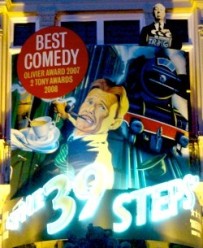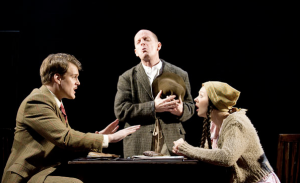Theatre: ‘BluePrince’ Review (SINGAPORE)
Posted: September 29, 2012 Filed under: Stage | Tags: BluePrince, Bryan Tan, Kuo Pao Kun, Oliver Chong, play, Singapore, stage, Substation, theatre Leave a commentWHAT: Play
WHERE: The Substation (map)
WHEN: 27th-29th Sept, 12
WHO: The Blue Statesmen
WEBSITE: www.substation.org/blueprince
PRICE: S$20 (S$15 concession)
MY THOUGHTS: As a foreigner who arrived in Singapore less than a month ago, I must confess that I have just began to learn about the local theatre culture. It was only last night that I heard about Kuo Pao Kun – a playwright, director, arts activist, and founder of The Substation who is hailed as the father of Singaporean theatre – to whom BluePrince pays tribute.
And perhaps it is because I have yet to come across any of Kuo’s plays that I came out of Bryan Tan’s BluePrince not having understood a thing about what just took place for the past hour.

BluePrince. Picture from The Substation’s website (http://www.substation.org/blueprince/).
I was at first intrigued by the set that greeted me. With spiral incense covering the ceiling and a mysterious, echoey narrative swirling around the room, it was as though we were transported to some sort of monastery. Oliver Chong, the only actor in the play, sat on a wooden chair engrossed in a book. Behind him, an assemblage of seemingly random white papier mache objects were lined up against the wall.
As the play began, Chong launched into a series of monologues as he brought each item to the middle of the stage in turn. He began with a speech about how his character’s lust for survival means that he is willing to eat his own family, and soon moved on to an unfinished narrative about his wife and daughter leaving him.
A 5-minute rant followed, repeating the process of how he walked to the tap, filled a glass and sipped the water. Fluorsent light tubes flickered on and off as Chong rearranged them into various shapes on the floor.
At this point I was still frantically, desperately, trying to make sense of the play, but each sketch became more bizarre and twisted than the last. When Chong stimulated an episode of self-cannibalism and told a story of how a lizard’s shrieking brought him to orgasm, however, the final shreds of my comprehension unravelled.
 I have come to the conclusion that there are three ways of looking at BluePrince. The first is that it is entirely a joke. We as the audience are not meant to take this seriously, and the ‘role of artists in society’ (as the brochure claims the play will interrogate) is merely to see how far they can push the audience’s tolerance of nonsense. Chong does, after all, stick his middle finger up at the crowd at one point. If this was indeed the intention, then the play is hugely successful in achieving its purpose – to mess with our heads as severely as possible.
I have come to the conclusion that there are three ways of looking at BluePrince. The first is that it is entirely a joke. We as the audience are not meant to take this seriously, and the ‘role of artists in society’ (as the brochure claims the play will interrogate) is merely to see how far they can push the audience’s tolerance of nonsense. Chong does, after all, stick his middle finger up at the crowd at one point. If this was indeed the intention, then the play is hugely successful in achieving its purpose – to mess with our heads as severely as possible.
The second interpretation is to take BluePrince as an attempt at serious theatre, in which case it didn’t do a very good job at all. It lacks plot, continuity, and most of all, meaning. Chong’s soliloquies sounded deep and philosophical, but they might as well have been cheap, nonsensical words. I have never been as confused about the point of a production as I was last night.
Upon some research, I discovered the third explanation – the stories and papier mache objects were actually symbolic of Kuo Pao Kun’s plays. The cat was meant to relate, I’m guessing, to Mama Looking For Her Cat; the car was a nod to No Parking On Odd Days; the story about a boy called Lao Jiu was directly taken from Lao Jiu.
Fair enough. As I mentioned, I would probably have appreciated BluePrince a lot more had my knowledge of Kuo been more solid. However, a successful production is one that could be understood even by someone who has no prior information about the subject matter. I would have liked to come out of the show with at least an idea of what Kuo might have been like as a man and a playwright, but unfortunately that didn’t happen. It was just an hour of references that were perhaps too specific for the unwitting audience to catch.
That said, Chong is no doubt a fantastic actor, as he successfully drew out his character’s sometimes stoic, sometimes elated, and sometimes downright grotesque nature. To have been able to travel through such a huge range of human – and sometimes even animalistic – conditions is no easy task, but he managed to stay focussed and convincing throughout.
I would love to hear what someone who is more familiar with Kuo’s works thinks about BluePrince (please do get in touch), but I would say that it’s not a play for those who do not have any background knowledge.
‘The 39 Steps’ Review (LONDON, UK)
Posted: November 29, 2011 Filed under: Stage | Tags: comedy, Criterion, london, play, review, stage, The 39 Steps, theatre, thriller, West End Leave a commentWHAT: Play (Comedy Thriller)
WHERE: Criterion Theatre (map)
WEBSITE: http://www.love39steps.com/
HOW MANY TOBIES WOULD GIVE LOUD DOG WHISTLES (out of 5):
MY STORY: The problem with watching the same play twice is that the second time usually disappoints. Especially if the first production you saw of it was pretty much the best thing you’ve ever seen performed on stage – as was the case with ‘The 39 Steps’. That was the first play I ever reviewed actually. I gave it four stars because at that point I didn’t feel confident enough giving it five, and I spent the next two years kicking myself because nothing I saw since was anywhere near as good as that. (Maybe with the exception of ‘Oklahoma!’ starring West End star Marti Webb, but that’s another story for another time.) So I sank into my seat at the Criterion Theatre with great expectations. And I was not in the least bit disappointed.
‘The 39 Steps’, for those of you who have been existing without having heard of it (shame on you), is a hilarious stage adaptation of the Hitchcock film adaptation of the book, which was originally written by John Buchan in 1915. (I hate italics, but it’s either that or caps because I need to show you visually exactly how funny it is, and I choose this. Or, I suppose, I should just put 😀 Would life be simpler if we all just communicated in smileys…? I digress) The book and film versions are both Very Serious Thrillers, but Patrick Barlow ingeniously turned it into a farce, and the result is fantastic. In fact, I’m convinced the world will be a better place if all plays are like this one, because it combines the best parts of theatre seamlessly, and I defy anyone to walk out of the performance not feeling happy as a duck.
In a nutshell, the plot revolves around Richard Hannay, who is on the run from the police after a ravishing spy he met at a London theatre (oooh – irony!), Annabella Schmidt, was murdered in his flat. In order to clear his name, Hannay needs to discover the reason for which Schmidt was assassinated. Her dying words revealed that a top state secret was about to be smuggled out of the country by foreign spies and if they succeed, ‘then Lord save us all’. And so begins Hannay’s adventures across the Scottish Moors, during which he meets a couple more beautiful women, including Pamela – to whom he reluctantly ends up being handcuffed with – a few not-so-attractive men, and a herd of sheep.
There are, in total, 139 roles in ‘The 39 Steps’ – and yet it only takes a(n absolutely brilliant) cast of four to have them covered. Andrew Alexander takes on the lead character, Catherine Bailey appears as all three of Hannay’s love interests, and Stephen Critchlow and Ian Hughes fill the remaining 135 characters between them, from Scottish inn-keepers to detectives to thorn bushes. Yes, thorn bushes. It is mesmerising to watch how quickly and precisely they can switch roles with swift changes of hats or positions or accents. They have, in short, found a solution to the question of how to be everyone everywhere at the same time. This is helped by a very versatile set: the wall of the inn, for example, magically transforms into a wardrobe, and the wardrobe somehow opens into a bed. Kudos to set designer Peter McKintosh. Genius.
The thing that amused me most, though, is how self-aware ‘The 39 Steps’ is. Certain lines are said before things happen, and thus a sofa flies on stage, or a telephone rings, only after a character demands them to. They use this joke a lot throughout the performance. It’s like their trump card. Does that sound forced? Maybe, but it works. It never gets old just because they know they’re being cheeky bums mocking conventional theatre techniques, but they also know that they can pull it off brilliantly. The play is made to seem spontaneous through very careful planning and fantastic execution. It is a case of art having successfully imitate life, and really, what more can you ask for in live theatre?
So if you, like Hannay, need ‘something mindless and trivial; something utterly pointless’ but guaranteed to make your entire day worth living for, then definitely, definitely (if I may commit the same crime twice), make time for ‘The 39 Steps’.
* ** *** ** *
INSIGHT

West End star Catherine Bailey, who plays all three female roles in The 39 Steps. Photo by James Looker.
Want to know what it’s like behind the scenes of a West End show? Click here for an exclusive interview with Catherine!











